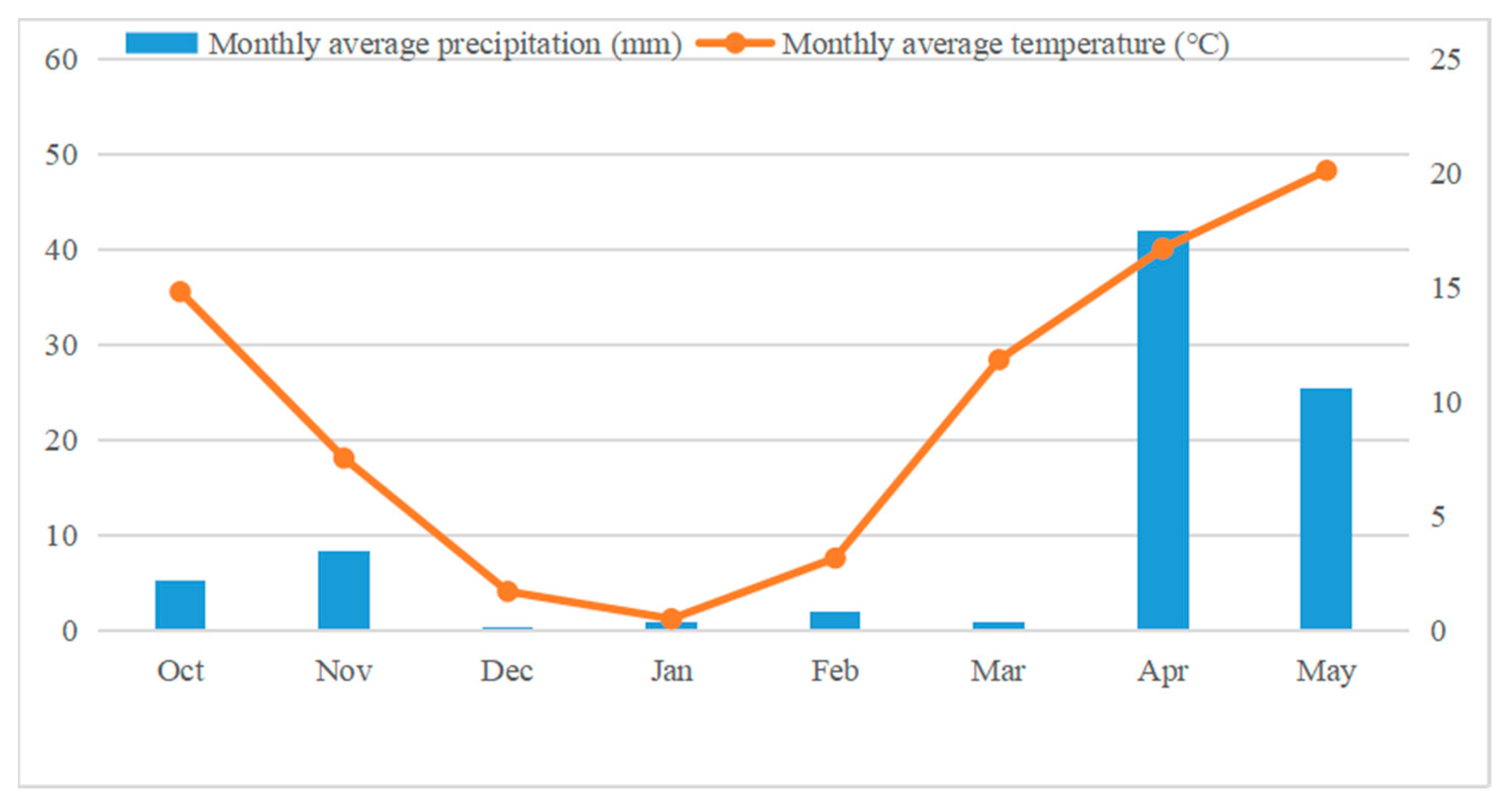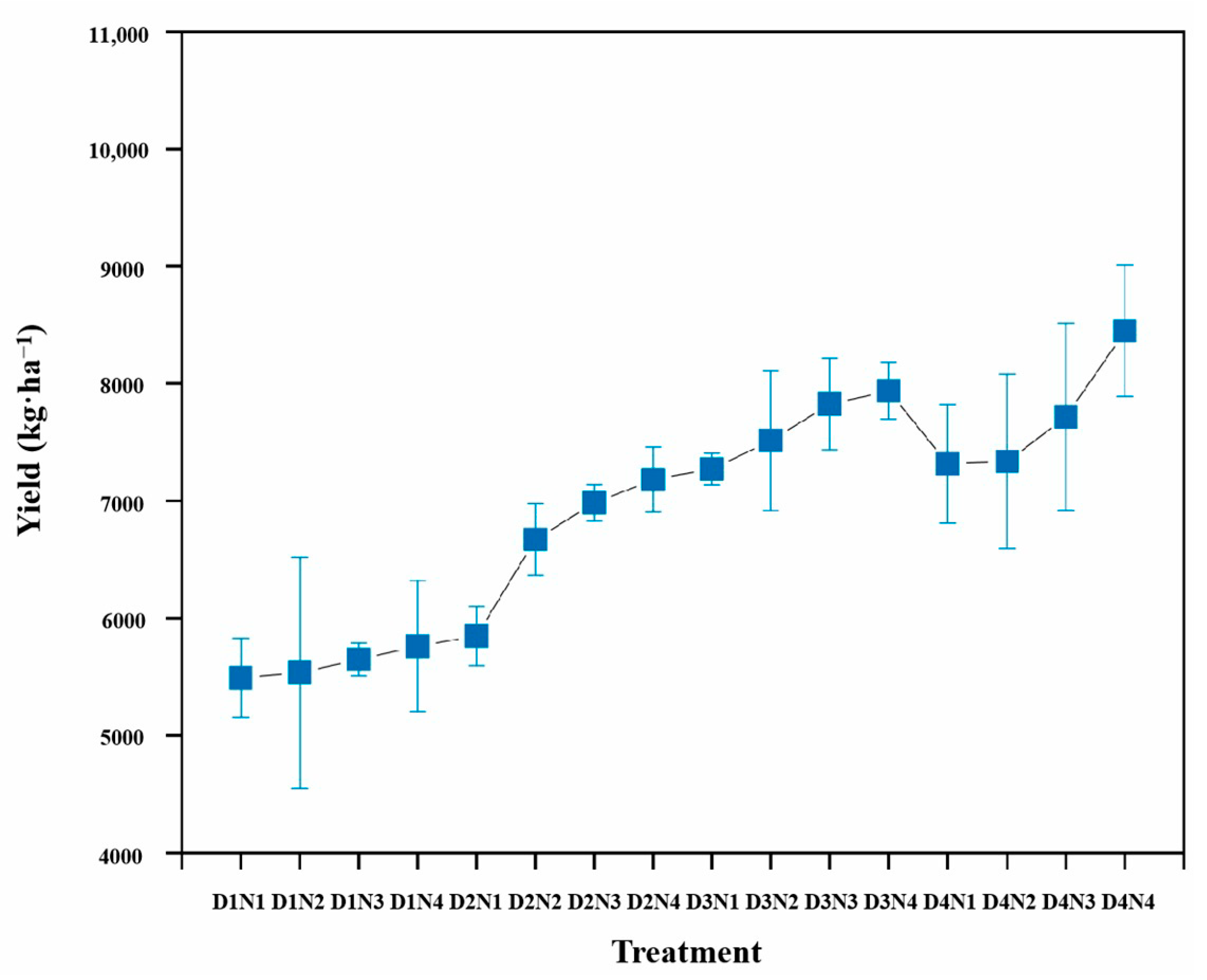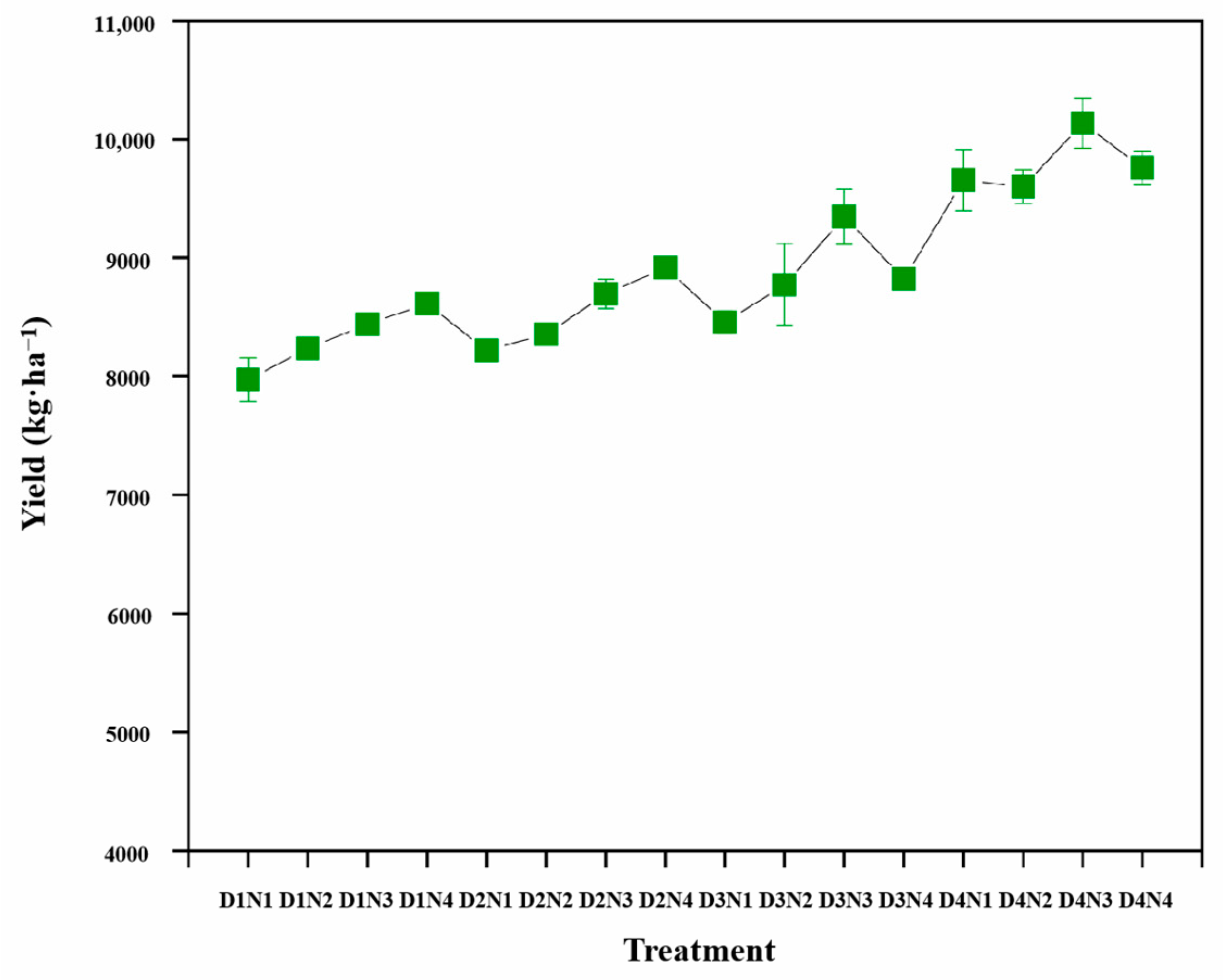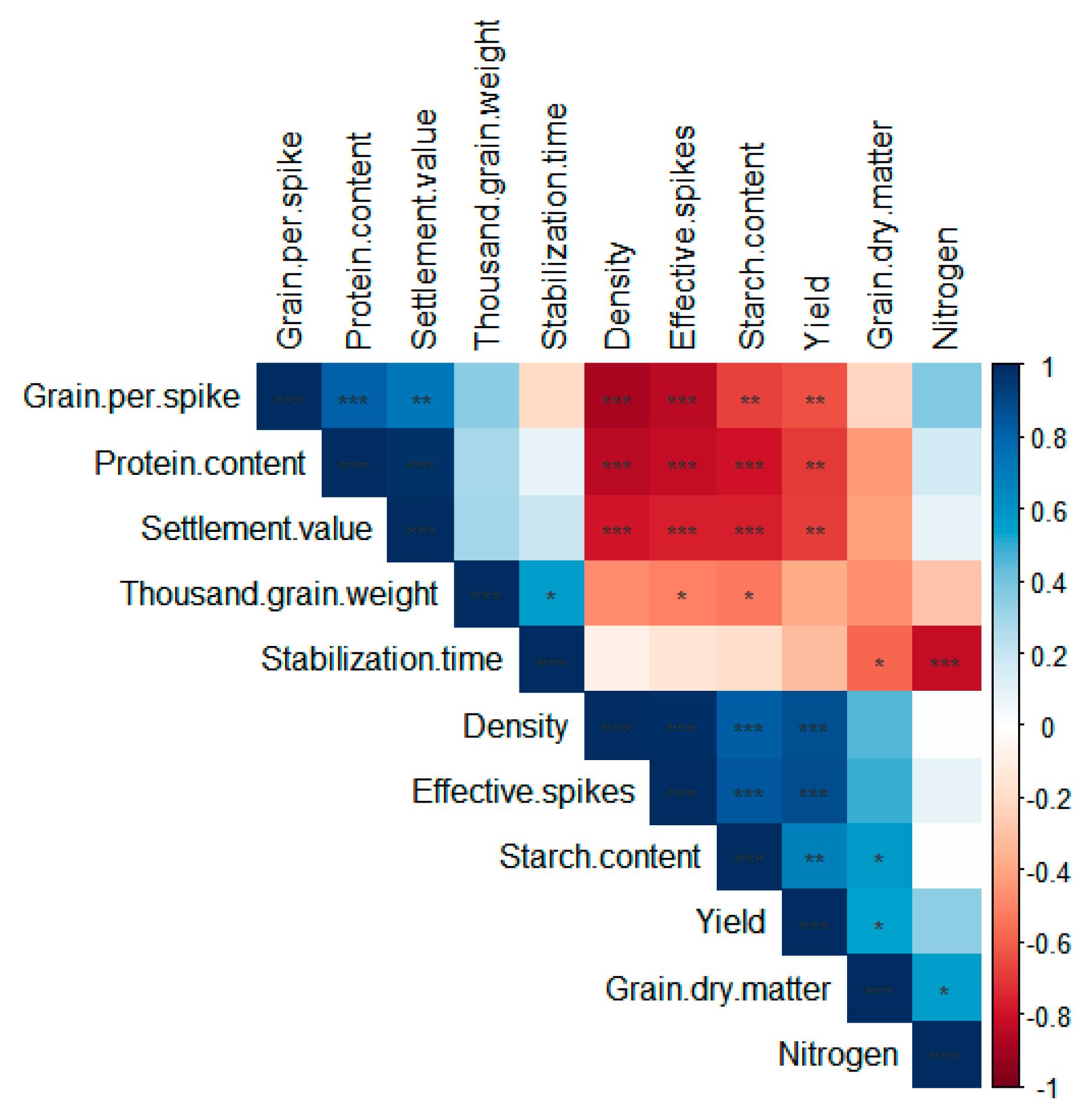The Effects of Different Sowing Density and Nitrogen Topdressing on Wheat Were Investigated under the Cultivation Mode of Hole Sowing
Abstract
1. Introduction
2. Materials and Methods
2.1. Test Designs
2.2. Determination Items and Methods
2.3. Statistical Analysis of Data
3. Results
3.1. Effects of Different Sowing Density and Nitrogen Topdressing on Dry Matter of Wheat Spikes
3.2. Effects of Different Sowing Density and Nitrogen Topdressing on Grain Quality
| Year | Sowing Density | Nitrogen Topdressing | Protein Content (%) | Stabilization Time (min) | Starch Content (%) | Settlement Value (mL) |
|---|---|---|---|---|---|---|
| 2018–2019 | D1 | N1 | 14.22 abc | 6.85 ab | 67.5 d | 50.77 abcd |
| N2 | 14.37 abc | 4.86 bcd | 68.47 abcd | 51.61 abc | ||
| N3 | 14.49 ab | 3.37 d | 67.68 cd | 52.06 abc | ||
| N4 | 14.53 ab | 2.97 d | 67.67 cd | 51.73 abc | ||
| D2 | N1 | 14.56 ab | 8.10 a | 67.63 cd | 53.84 a | |
| N2 | 14.38 abc | 4.31 bcd | 68.11 bcd | 50.66 abcd | ||
| N3 | 14.08 abc | 3.52 cd | 67.83 cd | 48.65 abcd | ||
| N4 | 14.65 a | 3.31 d | 67.41 d | 53.73 ab | ||
| D3 | N1 | 13.76 abc | 8.26 a | 68.39 abcd | 47.25 abcd | |
| N2 | 13.49 c | 3.17 d | 68.46 abcd | 43.60 d | ||
| N3 | 14.04 abc | 3.98 bcd | 68.76 abc | 49.51 abcd | ||
| N4 | 14.09 abc | 3.81 bcd | 68.48 abcd | 49.59 abcd | ||
| D4 | N1 | 13.57 c | 7.25 abc | 68.77 abc | 46.25 bcd | |
| N2 | 13.65 bc | 3.84 bcd | 69.38 a | 46.15 cd | ||
| N3 | 13.46 c | 2.25 d | 68.79 abc | 45.05 cd | ||
| N4 | 13.57 c | 2.89 d | 69.17 ab | 45.28 cd | ||
| F value | FD | 9.731 * | 0.518 | 13.854 *** | 7.398 * | |
| FN | 0.596 | 17.575 ** | 2.012 | 0.663 | ||
| FD × FN | 2.397 * | 3.945 ** | 0.508 | 2.090 * | ||
| 2019–2020 | D1 | N1 | 14.46 ab | 5.80 ab | 66.69 fg | 64.71 cd |
| N2 | 14.73 ab | 3.21 de | 67.38 defg | 67.35 ab | ||
| N3 | 15.41 ab | 3.23 de | 66.34 g | 67.85 ab | ||
| N4 | 15.58 a | 2.47 de | 67.57 def | 68.97 a | ||
| D2 | N1 | 14.43 ab | 7.90 a | 66.97 efg | 63.63 cd | |
| N2 | 15.56 ab | 4.47 bcd | 67.79 cde | 62.94 d | ||
| N3 | 15.41 ab | 4.63 bcd | 68.17 bcd | 64.22 cd | ||
| N4 | 15.47 ab | 3.04 de | 67.74 cdef | 65.88 bc | ||
| D3 | N1 | 15.22 ab | 8.03 a | 68.72 abc | 63.22 cd | |
| N2 | 15.49 ab | 4.00 cde | 67.79 cde | 64.07 cd | ||
| N3 | 15.25 ab | 3.45 de | 68.43 bcd | 63.48 cd | ||
| N4 | 15.02 ab | 3.04 de | 68.14 bcd | 63.75 cd | ||
| D4 | N1 | 14.49 ab | 6.59 abc | 69.1 ab | 62.61 d | |
| N2 | 14.67 ab | 3.95 cde | 69.05 ab | 63.18 cd | ||
| N3 | 14.28 b | 1.52 e | 69.13 ab | 63.48 cd | ||
| N4 | 14.66 ab | 2.47 de | 69.5 a | 63.41 cd | ||
| F value | FD | 3.193 * | 2.107 | 28.464 *** | 19.318 ** | |
| FN | 1.68 | 23.404 ** | 0.761 | 3.835 * | ||
| FD × FN | 1.552 | 5.425 ** | 2.524 * | 5.343 ** | ||
| FY | 14.533 *** | 4.392 | 68.157 | 56.828 *** | ||
| FY × FD | ns | ns | ns | ns | ||
| FY × FN | ns | *** | ns | ns | ||
| FY × FD × FN | ns | ns | ns | ns |
3.3. Effects of Different Sowing Density and Nitrogen Topdressing on Yield and Components
| Year | Sowing Density | Nitrogen Topdressing | Grain per Spike | Thousand-Grain Weight (g) | Effective Spikes (×104·ha−1) | Yield (kg·ha−1) |
|---|---|---|---|---|---|---|
| 2018–2019 | D1 | N1 | 37.30 bc | 47.05 | 462.52 d | 5491.63 e |
| N2 | 38.46 ab | 46.57 | 462.01 d | 5536.10 de | ||
| N3 | 38.78 a | 46.21 | 471.09 d | 5647.27 de | ||
| N4 | 38.82 a | 46.51 | 476.74 d | 5758.43 de | ||
| D2 | N1 | 37.18 bc | 46 | 516.04 cd | 5847.37 de | |
| N2 | 37.37 bc | 45.98 | 515.59 cd | 6670.00 cd | ||
| N3 | 37.66 abc | 46.44 | 518.48 cd | 6981.27 bc | ||
| N4 | 37.84 abc | 46.47 | 521.59 bc | 7181.379 bc | ||
| D3 | N1 | 36.63 cd | 47.74 | 578.96 bc | 7270.30 abc | |
| N2 | 36.87 cd | 45.99 | 580.29 bc | 7514.872 abc | ||
| N3 | 37.18 bc | 45.62 | 594.01 ab | 7826.17 abc | ||
| N4 | 37.26 bc | 46.27 | 604.87 ab | 7937.40 ab | ||
| D4 | N1 | 35.81 d | 46.4 | 624.76 ab | 7314.60 abc | |
| N2 | 35.78 d | 45.02 | 657.93 a | 7336.83 abc | ||
| N3 | 35.80 d | 45.33 | 634.60 ab | 7714.97 abc | ||
| N4 | 36.85 cd | 45.81 | 643.18 ab | 8448.67 a | ||
| F value | FD | 22.766 ** | 1.887 | 51.404 ** | 30.285 ** | |
| FN | 4.104 * | 1.357 | 1.298 | 4.165 * | ||
| FD × FN | 5.749 ** | 1.554 | 14.061 ** | 7.199 ** | ||
| 2019–2020 | D1 | N1 | 33.17 ab | 46.64 ab | 526.06 d | 7972.82 f |
| N2 | 33.76 a | 46.13 ab | 553.73 cde | 8235.37 ef | ||
| N3 | 33.93 a | 48.13 a | 536.27 cd | 8441.39 cdef | ||
| N4 | 33.56 a | 47.51 ab | 551.61 cd | 8614.47 bcdef | ||
| D2 | N1 | 32.13 abc | 47.82 ab | 562.62 bcde | 8220.78 ef | |
| N2 | 32.26 abc | 47.12 ab | 558.95 bcde | 8356.01 def | ||
| N3 | 31.57 abcd | 46.92 ab | 565.78 abcde | 8695.35 bcdef | ||
| N4 | 31.52 abcd | 46.88 ab | 574.29 abcde | 8916.96 abcdef | ||
| D3 | N1 | 30.29 abcd | 46.10 ab | 578.07 abcde | 8457.04 cdef | |
| N2 | 30.88 abcd | 45.51 b | 591.50 abcde | 8772.18 bcdef | ||
| N3 | 30.50 abcd | 45.27 b | 595.80 abcd | 9346.59 abcde | ||
| N4 | 29.43 bcd | 45.50 b | 603.10 abcd | 8821.08 bcdef | ||
| D4 | N1 | 28.32 d | 46.85 ab | 631.22 a | 9656.50 abc | |
| N2 | 29.20 cd | 46.24 ab | 621.45 abc | 9599.63 abcd | ||
| N3 | 32.64 abc | 46.351 ab | 626.31 ab | 10136.40 a | ||
| N4 | 31.95 abcd | 46.69 ab | 622.16 abc | 9758.71 ab | ||
| F value | FD | 7.556 ** | 5.796 ** | 7.122 ** | 12.187 ** | |
| FN | 0.822 | 0.759 | 0.172 | 1.943 | ||
| FD FN | 2.362 ** | 2.230 * | 2.267 * | 2.987 ** | ||
| FY | 34.397 *** | 46.409 | 567.549 | 7889.954 *** | ||
| FY × FD | ns | ns | ns | ns | ||
| FY × FN | ns | ns | ns | ns | ||
| FY × FD × FN | ns | ns | ns | ns |
3.4. Correlation Analysis of Different Indexes of Wheat
4. Discussion
5. Conclusions
Author Contributions
Funding
Institutional Review Board Statement
Data Availability Statement
Acknowledgments
Conflicts of Interest
References
- Clugston, G.A.; Smith, T.E. Global nutrition problems and novel foods. Asia Pac. J. Clin. Nutr. 2002, 11, S100–S111. [Google Scholar] [CrossRef]
- Rahman, S.; Zheleva, B.; Cherian, K.M.; Christenson, J.T.; Doherty, K.E.; de Ferranti, D.; Gauvreau, K.; Hickey, P.A.; Kumar, R.K.; Kupiec, J.K.; et al. Linking world bank development indicators and outcomes of congenital heart surgery in low-income and middle-income countries: Retrospective analysis of quality improvement data. BMJ Open 2019, 9, e028307. [Google Scholar] [CrossRef] [PubMed]
- Bongaarts, J. The State of Food Security and Nutrition in the World 2020. Transforming food systems for affordable healthy diets. Popul. Dev. Rev. 2021, 47, 558. [Google Scholar] [CrossRef]
- Shiferaw, B.; Smale, M.; Braun, H.-J.; Duveiller, E.; Reynolds, M.; Muricho, G. Crops that feed the world 10. Past successes and future challenges to the role played by wheat in global food security. Food Secur. 2013, 5, 291–317. [Google Scholar] [CrossRef]
- Gong, F.; Wu, X.; Zhang, H.; Chen, Y.; Wang, W. Making better maize plants for sustainable grain production in a changing climate. Front. Plant Sci. 2015, 6, 835. [Google Scholar] [CrossRef]
- Xu, H.; Twine, T.E.; Girvetz, E. Climate Change and Maize Yield in Iowa. PLoS ONE 2016, 11, e0156083. [Google Scholar] [CrossRef]
- Li, Q.L. The produce and consumption of wheat and wheat flour in China. Flour Milling 2006, 5, 9–14. [Google Scholar]
- El Serafy, S. System of Environmental-Economic Accounting 2012-Central Framework, United Nations, European Commission, Food and Agriculture Organisation of the United Nations, International Monetary Fund, Organisation for Economic Co-operation and Development and World Bank. Ecol. Econ. 2015, 112, 161–163. [Google Scholar] [CrossRef]
- Eser, A.; Kassai, K.M.; Kato, H.; Kunos, V.; Tarnava, A.; Jolankai, M. Impact of nitrogen topdressing on the quality parameters of winter wheat (Triticum aestivum L.) Yield. Acta Aliment. 2020, 49, 244–253. [Google Scholar] [CrossRef]
- Mohi-Ud-Din, M.; Rohman, M.M.; Alam, M.A.; Hasanuzzaman, M.; Islam, T. Wheat variety carrying 2N(v)S chromosomal segment provides yield advantage through lowering terminal heat-induced oxidative stress. Protoplasma 2023, 260, 63–76. [Google Scholar] [CrossRef]
- Fischer, T.; Ammar, K.; Monasterio, I.O.; Monjardino, M.; Singh, R.; Verhulst, N. Sixty years of irrigated wheat yield increase in the Yaqui Valley of Mexico: Past drivers, prospects and sustainability. Field Crop. Res. 2022, 283, 108528. [Google Scholar] [CrossRef]
- Mottaleb, K.A.; Kruseman, G.; Snapp, S. Potential impacts of Ukraine-Russia armed conflict on global wheat food security: A quantitative exploration. Glob. Food Secur.-Agric. Policy Econ. Environ. 2022, 35, 100659. [Google Scholar] [CrossRef]
- Sawaguchi, A.; Sato, M. Cultivation by early winter seeding of spring wheat in central Hokkaido-Suitable seeding density. Jpn. J. Crop Sci. 2001, 70, 505–509. [Google Scholar] [CrossRef]
- Valerio, I.P.; Felix de Carvalho, F.I.; de Oliveira, A.C.; Benin, G.; de Souza, V.Q.; Machado, A.d.A.; Bertan, I.; Busato, C.C.; da Silveira, G.; Rob Fonseca, D.A. Seeding density in wheat genotypes as a function of tillering potential. Sci. Agric. 2009, 66, 28–39. [Google Scholar] [CrossRef]
- Shah, F.; Wu, W. Soil and Crop Management Strategies to Ensure Higher Crop Productivity within Sustainable Environments. Sustainability 2019, 11, 1485. [Google Scholar] [CrossRef]
- Gao, Y.; Zhang, M.; Yao, C.; Liu, Y.; Wang, Z.; Zhang, Y. Increasing seeding density under limited irrigation improves crop yield and water productivity of winter wheat by constructing a reasonable population architecture. Agric. Water Manag. 2021, 253, 106951. [Google Scholar] [CrossRef]
- Zhang, D.Y.; Sun, G.J.; Jiang, X.H. Donald s ideotype and growth redundancy: A game theoretical analysis. Field Crop. Res. 1999, 61, 179–187. [Google Scholar] [CrossRef]
- Ma, S.-C.; Wang, T.-C.; Guan, X.-K.; Zhang, X. Effect of sowing time and seeding rate on yield components and water use efficiency of winter wheat by regulating the growth redundancy and physiological traits of root and shoot. Field Crop. Res. 2018, 221, 166–174. [Google Scholar] [CrossRef]
- Hiltbrunner, J.; Streit, B.; Liedgens, M. Are seeding densities an opportunity to increase grain yield of winter wheat in a living mulch of white clover? Field Crop. Res. 2007, 102, 163–171. [Google Scholar] [CrossRef]
- Soofizada, Q.; Pescatore, A.; Guerrini, L.; Fabbri, C.; Mancini, M.; Orlandini, S.; Napoli, M. Effects of Nitrogen plus Sulfur Fertilization and Seeding Density on Yield, Rheological Parameters, and Asparagine Content in Old Varieties of Common Wheat (Triticum aestivum L.). Agronomy 2022, 12, 351. [Google Scholar] [CrossRef]
- Chung, R.S.; Chen, H.T.; Wu, P.C. Effect of split applications of nitrogen fertilizer on the growth and nitrogen composition of Chinese mustard. Commun. Soil Sci. Plant Anal. 1999, 30, 307–316. [Google Scholar] [CrossRef]
- Liu, W.-Y.; Wu, C.-C.; Wang, S.-Y.S. Forest Management and Adaptation Strategies in Response to Climate Change by the Taiwanese Public. Atmosphere 2021, 12, 1056. [Google Scholar] [CrossRef]
- Ju, X.T.; Kou, C.L.; Zhang, F.S.; Christie, P. Nitrogen balance and groundwater nitrate contamination: Comparison among three intensive cropping systems on the North China Plain. Environ. Pollut. 2006, 143, 117–125. [Google Scholar] [CrossRef]
- Cordovil, C.M.d.s.; Cabral, F.; Coutinho, J. Potential mineralization of nitrogen from organic wastes to ryegrass and wheat crops. Bioresour. Technol. 2007, 98, 3265–3268. [Google Scholar] [CrossRef]
- Fang, Q.; Ma, L.; Yu, Q.; Malone, R.W.; Saseendran, S.A.; Ahuja, L.R. Modeling Nitrogen and Water Management Effects in a Wheat-Maize Double-Cropping System. J. Environ. Qual. 2008, 37, 2232–2242. [Google Scholar] [CrossRef]
- Jin, L.; Hu, K.; Deelstra, J.; Li, B.; Wei, D.; Wang, H. Evaluation of nitrogen fate, water and nitrogen use efficiencies of winter wheat in North China Plain based on model approach. Acta Agric. Scand. Sect. B-Soil Plant Sci. 2014, 63, 127–138. [Google Scholar] [CrossRef]
- Guo, R.; Nendel, C.; Rahn, C.; Jiang, C.; Chen, Q. Tracking nitrogen losses in a greenhouse crop rotation experiment in North China using the EU-Rotate_N simulation model. Environ. Pollut. 2010, 158, 2218–2229. [Google Scholar] [CrossRef]
- Wu, B.; Dong, Y.; Hai, J. Effect of Hole Seeding Way on Yield and Quality of Winter Wheat. Acta Agric. Boreali-Occident. Sin. 2019, 28, 906–913. (In Chinese) [Google Scholar]
- Qi, H.; Dong, Y.; Li, C.; Angelique Twizerimana Ren, H.; Hai, J. Effects of Sowing Methods and Seeding Rates on Yield and Quality of Winter Wheat Variety ‘Xinong 20’. Acta Agric. Boreali-Occident. Sin. 2021, 30, 32–40. (In Chinese) [Google Scholar]
- Sun, Y.T.; Yang, C.; Liang, H.J.; Yang, Y.Y.; Bu, K.M.; Dong, Y.L.; Hai, J.B. The Border Effects of Dry Matter, Photosynthetic Characteristics, and Yield Components of Wheat under Hole Sowing Condition. Agronomy 2023, 13, 766. [Google Scholar] [CrossRef]
- Lloveras, J.; Manent, J.; Viudas, J.; Lopez, A.; Santiveri, P. Seeding rate influence on yield and yield components of irrigated winter wheat in a Mediterranean climate. Agron. J. 2004, 96, 1258–1265. [Google Scholar] [CrossRef]
- Fageria, N.K.; Baligar, V.C. Enhancing nitrogen use efficiency in crop plants. Adv. Agron. 2005, 88, 97–185. [Google Scholar]
- Kanwal, A.; Zubair, D.; Rehman, R.M.u.; Ibrahim, M.; Bashir, M.A.; Maqbool, M.M.; Imran, M.; Rehman, U.u.; Nasif, O.; Ansari, M.J. The Impact of Seeding Density and Nitrogen Rates on Forage Yield and Quality of Avena sativa L. Biomed Res. Int. 2022, 2022, 8238634. [Google Scholar] [CrossRef] [PubMed]
- Banach, J.K.; Majewska, K.; Zuk-Golaszewska, K. Effect of cultivation system on quality changes in durum wheat grain and flour produced in North-Eastern Europe. PLoS ONE 2021, 16, e0236617. [Google Scholar] [CrossRef] [PubMed]
- Boiek, K.S.; Zuk-Golaszewska, K.; Bojarczuk, J.; Golaszewski, J. The Effect of Different Nitrogen Fertilizer Rates, Sowing Density, and Plant Growth Regulator Application on the Quality and Milling Value of Triticum durum Desf. Grain. Agronomy 2022, 12, 1622. [Google Scholar] [CrossRef]
- Chen, M.; Zhu, Y.H.; Ren, M.J.; Jiang, L.; He, J.; Dong, R. Does Belt Uniform Sowing Improve Winter Wheat Yield under High Sowing Density? Agronomy 2022, 12, 2936. [Google Scholar] [CrossRef]
- Marinho, J.D.; Silva, S.R.; Fonseca, I.C.D.; Zucareli, C. Nitrogen fertilization and sowing density on yield and physiological quality of wheat seeds. J. Seed Sci. 2022, 44, e202244013. [Google Scholar] [CrossRef]







| Year | Sowing Density | Nitrogen Topdressing | Booting Stage | Heading Stage | Flowering Stage | Filling Stage | Maturing Stage |
|---|---|---|---|---|---|---|---|
| 2018–2019 | D1 | N1 | 1.12 ab | 1.35 cde | 1.65 def | 1.68 g | 1.75 k |
| N2 | 1.06 ab | 1.42 abcde | 1.78 bcdef | 1.89 fg | 2.08 jk | ||
| N3 | 1.13 ab | 1.56 abc | 1.79 bcdef | 2.21 bcd | 2.35 hij | ||
| N4 | 1.12 ab | 1.39 bcde | 1.74 cdef | 2.18 bcd | 2.42 ghij | ||
| D2 | N1 | 0.98 ab | 1.23 de | 1.62 ef | 1.92 efg | 2.24 ij | |
| N2 | 1.03 ab | 1.27 de | 1.58 f | 1.92 efg | 2.29 hij | ||
| N3 | 1.07 ab | 1.38 bcde | 1.74 cdef | 2.01 def | 2.59 defgh | ||
| N4 | 0.96 ab | 1.19 e | 1.93 abcd | 2.17 bcde | 2.53 efghi | ||
| D3 | N1 | 1.12 ab | 1.48 abcd | 1.92 abcd | 2.07 cdef | 2.44 fghi | |
| N2 | 0.94 b | 1.26 de | 1.99 abc | 1.99 def | 2.77 cdef | ||
| N3 | 0.88 b | 1.42 abcde | 1.88 abcde | 2.13 cdef | 2.81 cde | ||
| N4 | 1.22 a | 1.36 bcde | 1.92 abcd | 2.39 b | 3.07 abc | ||
| D4 | N1 | 0.93 b | 1.57 abc | 1.91 abcde | 2.19 bcd | 2.75 cdefg | |
| N2 | 0.97 ab | 1.57 abc | 1.91 abcde | 2.3 bc | 2.92 bcd | ||
| N3 | 1.06 ab | 1.62 ab | 2.04 ab | 2.99 a | 3.19 ab | ||
| N4 | 1.22 a | 1.66 a | 2.13 a | 3.09 a | 3.39 a | ||
| F value | FD | 1.117 | 14.17 *** | 10.608 *** | 54.44 *** | 214.04 *** | |
| FN | 1.95 | 1.95 | 2.423 | 39.23 *** | 79.96 *** | ||
| FD × FN | 2.15 | 0.893 | 1.209 | 4.109 * | 0.047 | ||
| 2019–2020 | D1 | N1 | 0.98 cd | 1.17 f | 1.45 i | 1.83 f | 1.90 h |
| N2 | 1.06 bcd | 1.34 def | 1.66 ghi | 1.77 f | 2.04 gh | ||
| N3 | 1.13 bcd | 1.44 cd | 1.73 fghi | 1.89 ef | 2.14 gh | ||
| N4 | 1.16 abc | 1.42 cde | 1.8 defgh | 1.88 ef | 2.16 g | ||
| D2 | N1 | 0.98 cd | 1.41 cde | 1.75 efghi | 1.96 ef | 2.07 gh | |
| N2 | 1.03 bcd | 1.34 def | 1.59 hi | 1.83 f | 2.08 gh | ||
| N3 | 1.07 bcd | 1.41 cde | 1.62 hi | 1.86 f | 1.91 gh | ||
| N4 | 0.99 cd | 1.48 cd | 1.73 fghi | 2.09 de | 2.45 f | ||
| D3 | N1 | 1.12 bcd | 1.54 bc | 1.96 cdefg | 2.24 cd | 2.52 ef | |
| N2 | 0.94 cd | 1.24 ef | 1.81 defgh | 2.27 cd | 2.71 cde | ||
| N3 | 0.91 d | 1.31 def | 2.01 cdef | 2.43 c | 2.57 ef | ||
| N4 | 1.25 ab | 1.46 cd | 2.06 bcde | 2.41 c | 2.88 bcd | ||
| D4 | N1 | 0.93 cd | 1.37 cdef | 2.13 bcd | 2.34 c | 2.64 def | |
| N2 | 1 cd | 1.49 cd | 2.35 ab | 2.84 b | 2.95 bc | ||
| N3 | 1.09 bcd | 1.73 ab | 2.24 bc | 2.96 ab | 3.08 ab | ||
| N4 | 1.39 a | 1.81 a | 2.67 a | 3.08 a | 3.3 a | ||
| F value | FD | 2.876 * | 8.932 *** | 46.67 *** | 91.733 *** | 105.9 *** | |
| FN | 0.728 | 5.437 ** | 16.16 *** | 6.903 *** | 15.8 *** | ||
| FD × FN | 1.093 | 5.205 *** | 1.206 | 6.291 *** | 3.128 ** | ||
| FY | 1.058 | 1.428 | 1.878 | 2.234 | 2.467 | ||
| FY × FD | ns | ** | * | ** | * | ||
| FY × FN | ns | ns | ns | ns | ns | ||
| FY × FD × FN | ns | ns | ns | ns | ns |
Disclaimer/Publisher’s Note: The statements, opinions and data contained in all publications are solely those of the individual author(s) and contributor(s) and not of MDPI and/or the editor(s). MDPI and/or the editor(s) disclaim responsibility for any injury to people or property resulting from any ideas, methods, instructions or products referred to in the content. |
© 2023 by the authors. Licensee MDPI, Basel, Switzerland. This article is an open access article distributed under the terms and conditions of the Creative Commons Attribution (CC BY) license (https://creativecommons.org/licenses/by/4.0/).
Share and Cite
Sun, Y.; Yang, W.; Wu, Y.; Cui, Y.; Dong, Y.; Dong, Z.; Hai, J. The Effects of Different Sowing Density and Nitrogen Topdressing on Wheat Were Investigated under the Cultivation Mode of Hole Sowing. Agronomy 2023, 13, 1733. https://doi.org/10.3390/agronomy13071733
Sun Y, Yang W, Wu Y, Cui Y, Dong Y, Dong Z, Hai J. The Effects of Different Sowing Density and Nitrogen Topdressing on Wheat Were Investigated under the Cultivation Mode of Hole Sowing. Agronomy. 2023; 13(7):1733. https://doi.org/10.3390/agronomy13071733
Chicago/Turabian StyleSun, Yitao, Wenlong Yang, Yilun Wu, Youhe Cui, Yongli Dong, Zhoujia Dong, and Jiangbo Hai. 2023. "The Effects of Different Sowing Density and Nitrogen Topdressing on Wheat Were Investigated under the Cultivation Mode of Hole Sowing" Agronomy 13, no. 7: 1733. https://doi.org/10.3390/agronomy13071733
APA StyleSun, Y., Yang, W., Wu, Y., Cui, Y., Dong, Y., Dong, Z., & Hai, J. (2023). The Effects of Different Sowing Density and Nitrogen Topdressing on Wheat Were Investigated under the Cultivation Mode of Hole Sowing. Agronomy, 13(7), 1733. https://doi.org/10.3390/agronomy13071733






